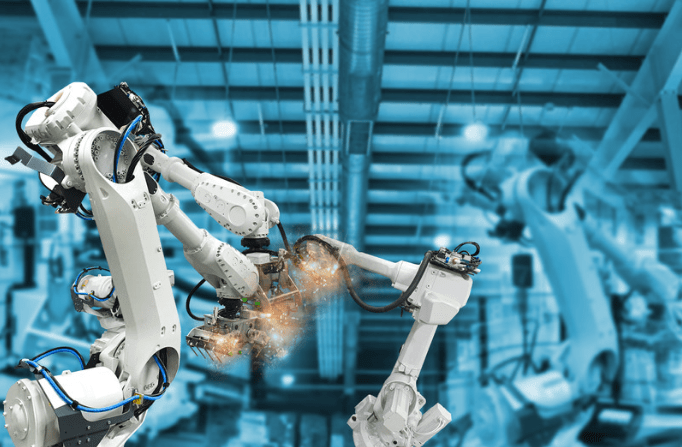
Service robots are becoming increasingly integral to manufacturing due to their undeniable benefits. The use of industrial robots is expected to grow significantly as their technology continues to advance.
Technologies such as sensors, collaborative robots, and software solutions enhance safety by facilitating efficient human-robot collaboration and ensuring compliance with safety standards.
This approach significantly reduces risks such as unexpected movements, system failures, collisions, and electrical hazards by following robust safety protocols.
What are the main benefits and challenges that the future holds for industrial robotics?

Industrial robots have become essential in manufacturing, revolutionizing production with increased speed and precision. As mentioned earlier, the demand for these robotic applications will continue rising. One of the future challenges in this field is further reducing the risks associated with using service robots in industrial settings.
This applies universally across all industrial sectors. Employee safety is paramount, and companies must comply with stringent health and safety regulations while implementing practices that minimize accident risks. Many business leaders recognize the advantages of automating production processes. Robotic applications not only boost operational efficiency but also significantly enhance employee protection.
Machines perform the most strenuous tasks, reducing the need for workers to be near them during operation. Once programmed, these machines function autonomously, providing a substantial safety advantage and making a strong case for adopting this technology.
Service robots in industries offer undeniable advantages. One key benefit is protecting workers’ health and lives through automation. Handling heavy materials, manipulating them, or performing monotonous tasks in a seated position can adversely affect workers’ health. By assigning these tasks to robots, companies enhance employee safety by safeguarding their health and reducing the risk of severe workplace accidents. This also lowers employer costs related to long-term employee absences due to challenging working conditions necessitating medical treatment or rehabilitation.
When considering the uses of robotics in industrial settings, it’s also important to note the additional benefit of increased work efficiency. Modern robots offer several advantages:
Moreover, machines operate faster than humans, which, combined with these features, boosts the efficiency of many industrial processes. Robotics can effectively replace humans in tasks like palletizing, depalletizing, or operating CNC injection molding machines, allowing employees to focus on more complex, safer tasks that require higher qualifications.
Establishing comprehensive safety protocols is essential for maintaining a safe work environment. Training employees in safety practices and emergency response ensures that safety remains a top priority. Regular drills and refresher courses help keep safety at the forefront, empowering employees to report potential risks and suggest improvements.
Advanced safety technologies play a crucial role in creating secure environments where humans and robots work together in industrial settings:
Additionally, regulations and standards are in place to ensure the safe use of industrial robots:
Spot, the quadruped robot from Boston Dynamics, exemplifies a service robot that has been enhanced with cutting-edge features to improve its functionality in industrial settings. These updates include acoustic vibration detection for better predictive maintenance and 3D scanning for mapping industrial environments.
A major update is the addition of acoustic vibration inspection. Spot can now proactively monitor industrial equipment using acoustic leak detection. With the integration of the Fluke SV600 acoustic imager, Spot performs ultrasonic inspections of rotating machinery to detect vibration anomalies. This capability allows operators to identify early signs of bearing failures, preventing costly and unexpected downtimes.
Another significant advancement is the integration of laser scanning for capturing environmental data. Equipped with the Leica BLK ARC scanner, Spot can undertake “reality capture” missions similar to inspection tasks. This scanning ability enables the creation of visual representations of existing spaces, route planning, and identification of potential conflicts during equipment installation. It also aids in training new employees more efficiently. The 3D data collected is valuable for factory design, equipment installation, and change management, especially in challenging and hazardous environments like mines.
Spot’s ability to navigate obstacles has been improved. The update enhances Spot’s perception by integrating visual semantic context into its navigation system. Spot can now detect and avoid obstacles such as carts, wires, and stairs, in addition to moving objects.
Spot’s hardware has also been upgraded. A new tablet controller with ergonomic joysticks offers a better user experience with a lightweight design, larger buttons, and additional controls. Spot now supports an extended operating temperature of up to 55°C (previously 45°C). Additionally, an improved antenna on the Core I/O provides greater reliability and range.
The Orbit fleet management platform, now at version 4.1, has also received updates. Orbit enables operators and asset managers to manage robots, view and analyze data, and integrate this data into existing enterprise systems. New features include support for multi-docking, allowing Spot to autonomously recharge along its route, thus extending mission duration on large sites. A new alert triage interface has been introduced for quick processing of critical alarms, grouping, and archiving with a single click.
Emerging advancements in service robots, including the robotic nurses we’ve discussed, are set to broaden their applications within industrial sectors. These innovations are on the brink of transforming the industry, with an increasing emphasis on safety and enhanced production efficiency.
We’re here to help! Whether you have questions, need support, or want to know more about us and our services, fill out the form below and our team will get back to you promptly.
Let’s explore the future of AI and robotics together.
